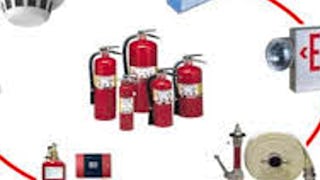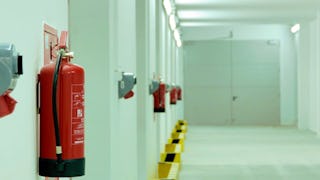In the comprehensive exploration of "Types of Fire Detection Systems" within the course module, participants embark on a journey through the intricacies of fire safety. The module kicks off by emphasizing the pivotal role fire detection systems play in building safety, particularly in identifying and responding to fires during their early stages. This early detection not only ensures the safety of occupants but also provides ample time for a well-organized evacuation. The installation of these systems is highlighted as a proactive measure to mitigate property loss and minimize facility downtime through swift identification.

Enjoy unlimited growth with a year of Coursera Plus for $199 (regularly $399). Save now.

Fire Detection & Fire Alarm Systems and Safety Signages
This course is part of Fire and Life Safety Systems Specialization

Instructor: Subject Matter Expert
2,248 already enrolled
Included with
(31 reviews)
Recommended experience
Skills you'll gain
Details to know

Add to your LinkedIn profile
3 assignments
See how employees at top companies are mastering in-demand skills

Build your subject-matter expertise
- Learn new concepts from industry experts
- Gain a foundational understanding of a subject or tool
- Develop job-relevant skills with hands-on projects
- Earn a shareable career certificate

There are 3 modules in this course
Fire detection systems are crucial for building safety, providing early warnings and enabling prompt evacuations. This module explores various types of fire detection and alarm systems, emphasizing their role in minimizing property loss and downtime. Participants learn about different fire detection devices and their specific functions. Instructors guide them in selecting appropriate detectors based on hazards and standards, considering factors like detection speed and false alarm reduction. Real-world applications demonstrate the effectiveness of heat, smoke, and aspirating detectors in diverse scenarios. By understanding hazard categories and standards, participants gain insights into informed detector selection. This comprehensive training equips participants with essential knowledge for effective emergency response and property protection.
What's included
18 videos1 assignment
In this module, we'll delve into the core concepts of fire alarm notification devices, covering key terminologies and various device types and modes. We'll discuss strategic placement strategies to optimize effectiveness in terms of visibility, audibility, or a combination of both. We'll explore the historical evolution of fire detectors, focusing on terminology and coverage intricacies, particularly concerning heat and smoke detectors as per Indian Standard 2189. Advanced detectors like aspiration and beam detectors will be examined for their unique coverage attributes. Considerations for detector placement, especially related to air movement, will be emphasized through practical scenarios. Inspection, testing, and maintenance practices for system reliability will be highlighted, along with integrating fire alarms with building systems and understanding the Cause & Effect Matrix. A live demonstration will illustrate the integration of Cause & Effect Matrix with fire alarm systems for practical understanding. By the course's end, participants will be equipped with the necessary knowledge and skills for effective implementation, integration, and maintenance of fire alarm notification devices across diverse building environments.
What's included
22 videos1 assignment
Fire safety signages are essential visual aids for conveying critical information during emergencies. This module explores their role in promoting safety and aiding in evacuation. Categorized by functionality, they include warning signs for hazards, egress signs for safe evacuation routes, and firefighting equipment signs for locating essential tools like fire extinguishers. Emphasis is placed on proper placement and visibility, ensuring easy noticeability for effective emergency response. Prohibition signs prevent unsafe practices, while health and safety signs complement fire-specific communication. Discussions cover sign dimensioning, color coding, and luminescent photo safety signage for low-light visibility. Instructor-led sessions cover detector technologies, selection, and coverage as per standards. Integration with building services, inspection practices, and the cause-and-effect matrix are also addressed. Ultimately, participants gain a comprehensive understanding of fire safety signages' vital role in evacuation and workplace safety.
What's included
16 videos1 assignment
Earn a career certificate
Add this credential to your LinkedIn profile, resume, or CV. Share it on social media and in your performance review.
Instructor

Offered by
Explore more from Mechanical Engineering

L&T EduTech

L&T EduTech
Why people choose Coursera for their career





Open new doors with Coursera Plus
Unlimited access to 10,000+ world-class courses, hands-on projects, and job-ready certificate programs - all included in your subscription
Advance your career with an online degree
Earn a degree from world-class universities - 100% online
Join over 3,400 global companies that choose Coursera for Business
Upskill your employees to excel in the digital economy
Frequently asked questions
To access the course materials, assignments and to earn a Certificate, you will need to purchase the Certificate experience when you enroll in a course. You can try a Free Trial instead, or apply for Financial Aid. The course may offer 'Full Course, No Certificate' instead. This option lets you see all course materials, submit required assessments, and get a final grade. This also means that you will not be able to purchase a Certificate experience.
When you enroll in the course, you get access to all of the courses in the Specialization, and you earn a certificate when you complete the work. Your electronic Certificate will be added to your Accomplishments page - from there, you can print your Certificate or add it to your LinkedIn profile.
Yes. In select learning programs, you can apply for financial aid or a scholarship if you can’t afford the enrollment fee. If fin aid or scholarship is available for your learning program selection, you’ll find a link to apply on the description page.
More questions
Financial aid available,


